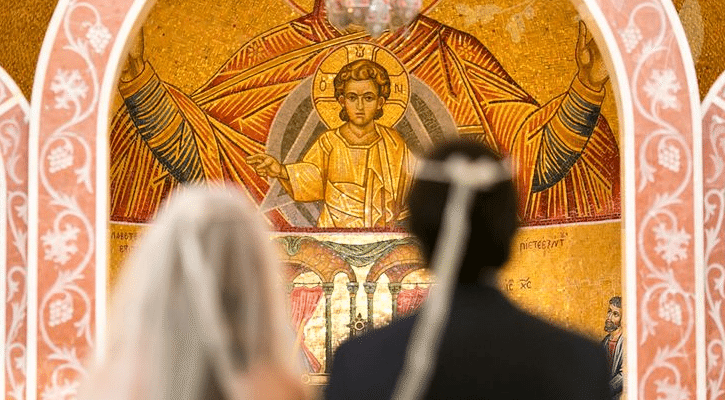by Emmanuel Mendonca and FavorIdeas
The traditional wedding service in the Greek Orthodox faith is an ancient and gorgeous ceremony that’s continued unchanged for centuries. It’s also a ceremony full of symbolism. And it amounts to a great experience if you’ve never attended one before, because it’s likely to be quite different from other weddings you’ve been to. Many people find the service itself rather unique. The bride and groom don’t make vows to each other — it’s understood that standing together in the church shows they’re serious about getting married.
How it All Begins …
In most cases, the wedding guests wait with the groom outside the church until the bride arrives (a few sneaky wedding pros will go into the church early to secure a good seat). In summer, when most weddings take place, it’s not unusual for ceremonies to be scheduled back to back. So the wedding guests will often hang around with those who’ve just attended the previous wedding as they prepare to leave. The crowd’s professional wedding commentators will get to talk over at least two and maybe even three brides as they leave the church (bargain)!
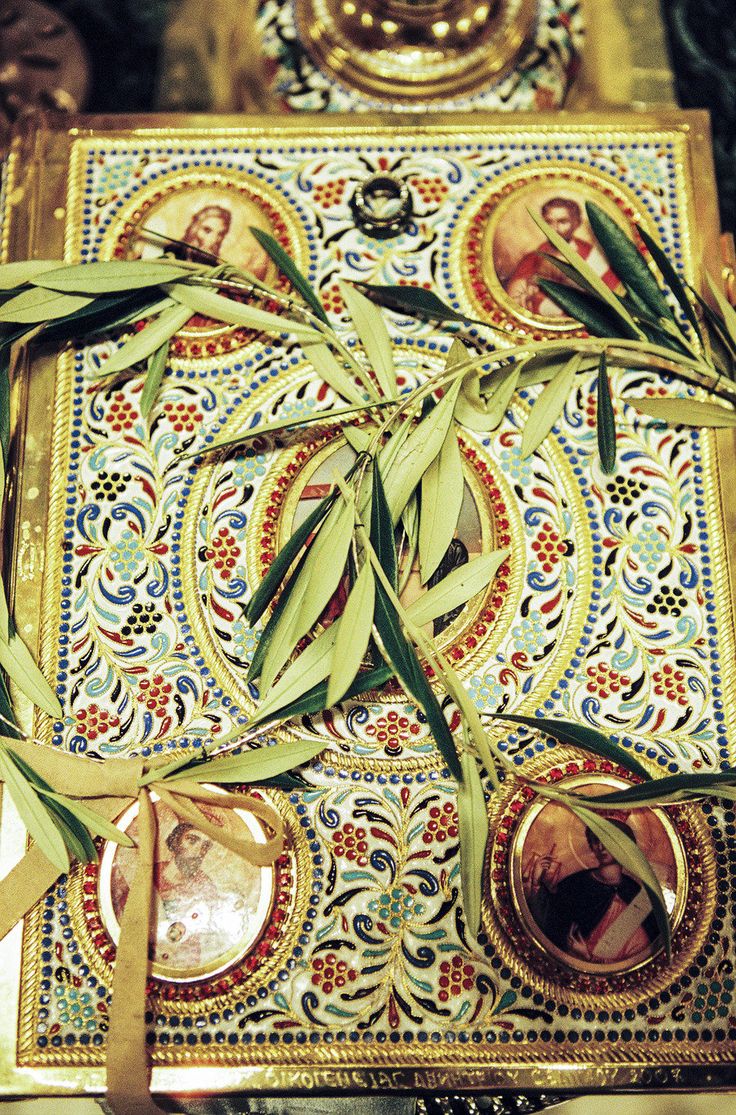
Meanwhile, the nervous groom waits for the bride at the entrance to the church, often holding her bouquet. He hands it to her as they meet. Then they stroll inside together, followed by the guests. There’s no dividing guests into those “for the bride” or “for the groom” — everyone sits together, and in the case of small churches, many people actually prefer to stand somewhere that offers a great view of the proceedings.
Service of Betrothal
The wedding ceremony itself takes place in two parts: the Service of Betrothal, and the Ceremony of the Sacrament of Marriage. The Service of Betrothal focuses on the ring exchange. The priest blesses the rings by holding them in his right hand, and makes the sign of the cross over the the bride’s and groom’s heads. He then places the rings on the third fingers of their right hands.
The “Koumbaro,” the couple’s religious sponsor, then swaps the rings three times between the bride and groom’s fingers. A number of rituals in the ceremony are repeated three times, which symbolizes the Holy Trinity.
Ceremony of the Sacrament of Marriage
This Ceremony consists of several key parts. First, the priest leads several prayers. Then, as they come to an end, he joins the right hands of the bride and groom. Their hands remain joined until the wedding ceremony ends, which symbolizes their union.
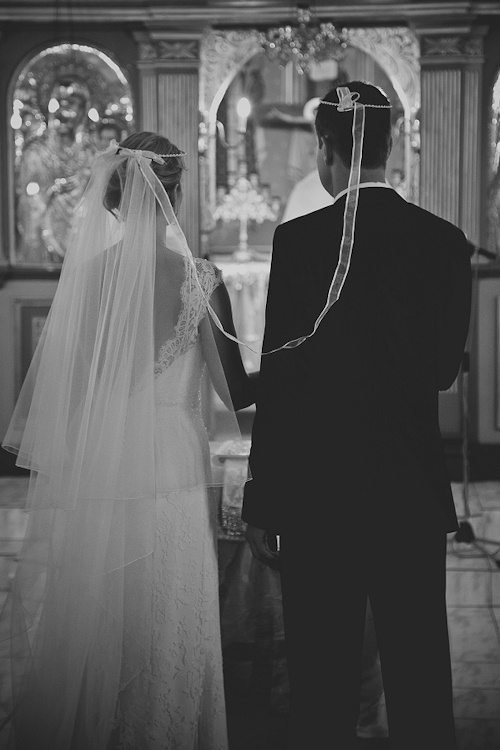
The Crowning
The bride and groom are crowned with flowered crowns, or “stefana”, which are joined by a white ribbon and have been blessed by the priest. The crowns symbolize the glory and honor bestowed on them by God, and the the ribbon signifies the couple’s unity. The “Koumbaro” then exchanges the crowns three times between the couple’s heads.
The Common Cup
The priest follows the crowning with a Gospel reading, which tells of the marriage of Cana at Galilee. It was at this wedding that Jesus performed his first miracle, changing water into wine and offering the result to the married couple. Repeating this ritual, the priest gives wine to the couple. They each drink from the cup three times.
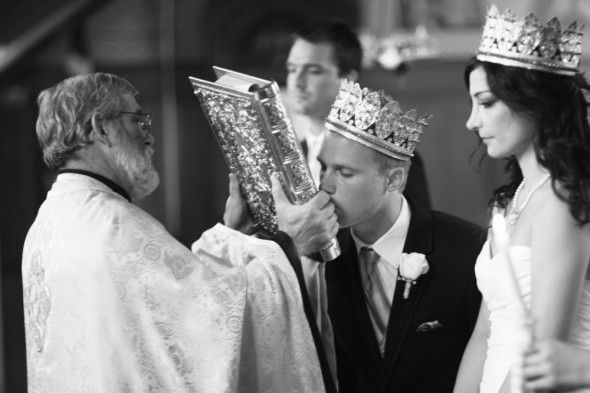
The Ceremonial Walk
The priest now leads the stafana-crowned couple three times around the altar, which amounts to their first steps as a married couple. The “Koumbaro” follows close behind, holding the stefana in place. At this point the couple (and anyone standing nearby) is usually pelted with rice, which ushers handed out earlier to the guests. The rice throwing can get pretty wild — and it’s not unusual to catch the priest warding off the rice assault with his Bible.
The Removal of the Crowns
When the Ceremonial Walk ends, the priest then blesses the couple, removes the crowns and separates their previously-joined hands with the Bible, reminding them that only God can break the union they’ve just entered into.
Wedding Traditions and Where They’re Headed
Much of the information available on Greek Orthodox wedding traditions is slightly outdated, and sometimes gives the impression that every Greek couple who marries still follows them. Some of these waning traditions include:
- Rolling a baby on the marital bed to encourage fertility.
- Throwing money onto the marital bed.
- Pinning money on the bride (and sometimes the groom) at the wedding reception.
Although these rituals are seen as traditional, fewer and fewer young people are adopting them — they seem rather old-fashioned, just as the Dollar Dance seems somewhat outdated to some American brides. After all, many couples don’t want to put their guests through the ordeal of having a monetary gift put on public display. Although money’s still a very common (as well as practical and appreciated) wedding present, guests often give it to the couple ahead of time, or hand it to someone like the best man at the reception for safekeeping.
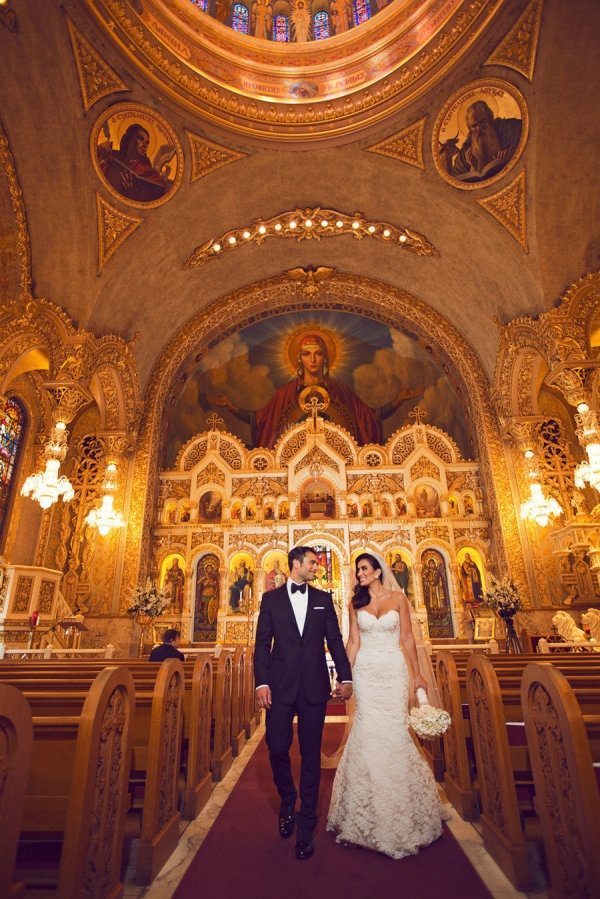
Greeks living in the more remote parts of Greece and abroad, who often feel more strongly about doing things the traditional way, are more likely to follow these traditions than a young couple living in Athens. Still, like weddings everywhere, Greek weddings are changing. At the time of this writing, there’s a growing fashion to go and get married on an island, and I recently heard someone say that he was looking into getting married in a ski resort.
Not everyone is leaping head first into nontraditional weddings, however. As his friend wisely pointed out, “You’d better first ask the priest if he wants to perform a marriage up a mountain!”


